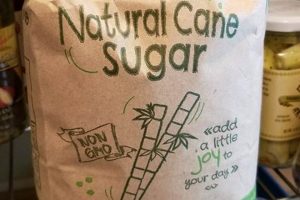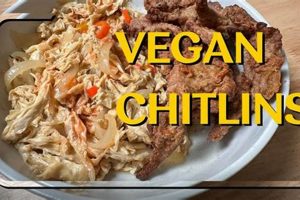This food additive, derived from the fermentation of sugars by the bacterium Xanthomonas campestris, serves as a thickening and stabilizing agent in a wide array of food products. Its plant-based origin and fermentation process render it suitable for individuals adhering to plant-based dietary practices. It enhances viscosity and prevents separation in products like sauces, dressings, and baked goods.
Its significance in the food industry stems from its ability to improve texture and shelf-life without relying on animal-derived ingredients. Historically, this characteristic has made it a crucial component in formulating products that cater to specialized dietary needs and preferences. The consistent performance of this additive in diverse applications contributes significantly to product quality and appeal.
The following sections will delve deeper into its applications within various food categories, examining its impact on product characteristics and exploring its role in modern culinary innovation. Specific considerations regarding its use in vegan product formulations will also be discussed.
Usage Guidance
Effective application of this versatile ingredient hinges on understanding its properties and interactions within different formulations. Proper handling ensures optimal texture and stability in the final product.
Tip 1: Hydration is Key: Ensure proper dispersion in a liquid medium before introducing to other ingredients. This prevents clumping and promotes uniform thickening.
Tip 2: Consider the pH: The stability is generally unaffected by pH within a wide range (3-12), but extreme acidity or alkalinity may slightly alter its performance. Conduct small-scale testing for highly acidic or alkaline recipes.
Tip 3: Heat Tolerance: It remains stable under high-heat conditions, making it suitable for cooked and baked products. However, prolonged exposure to very high temperatures may reduce viscosity slightly.
Tip 4: Synergistic Effects: It exhibits synergistic effects with other hydrocolloids, such as guar gum or locust bean gum, potentially reducing the required concentration for a desired level of viscosity. Explore these combinations for cost-effectiveness and improved texture.
Tip 5: Dosage Matters: Begin with low concentrations (typically 0.1% to 1% by weight) and adjust as needed. Overuse can result in an undesirable slimy texture.
Tip 6: Application in Baking: In gluten-free baking, it mimics gluten’s elasticity and binding properties. Experiment with different concentrations to achieve the optimal crumb structure.
Tip 7: Stabilizing Emulsions: This ingredient effectively stabilizes emulsions, preventing separation in sauces, dressings, and beverages. Proper emulsification techniques, combined with it, enhance product stability and shelf life.
By adhering to these guidelines, manufacturers and culinary professionals can leverage its capabilities to enhance the texture, stability, and overall quality of a broad spectrum of food and beverage applications.
The subsequent sections will provide detailed case studies illustrating the application in specific food products, as well as a discussion of potential regulatory considerations.
1. Plant-Based Source
The classification of xanthan gum as suitable for vegan diets is intrinsically linked to its production process, which originates entirely from plant-based sources. Specifically, it is a polysaccharide produced through the fermentation of simple sugars, such as glucose or sucrose, by the bacterium Xanthomonas campestris. This fermentation process yields a broth containing the polysaccharide, which is then recovered, dried, and milled into a powder. Because the entire process relies on microbial action on plant-derived substrates, without involving any animal products or byproducts, it unequivocally qualifies as plant-based. Without this plant-based origin, it could not be considered appropriate for vegan consumption.
The importance of the plant-based origin extends beyond simply meeting dietary restrictions. It aligns with ethical considerations concerning animal welfare and environmental sustainability often associated with veganism. For example, many conventional food additives may involve animal testing during their development or may be derived from animal sources. This plant-based additive avoids these concerns, presenting a more ethically sound option for manufacturers and consumers. Furthermore, the utilization of plant-derived sugars for fermentation reduces reliance on non-renewable resources and potentially lowers the environmental impact of food production.
In summary, the plant-based source is not merely a characteristic of this additive, but a fundamental requirement for its acceptance within the vegan dietary framework. This origin ensures adherence to both the nutritional and ethical principles underlying veganism, contributing to the integrity and credibility of products labeled as vegan. Understanding this connection is crucial for both consumers seeking assurance of product suitability and manufacturers aiming to cater to the growing demand for plant-based alternatives.
2. Fermentation Process
The fermentation process is central to understanding why xanthan gum aligns with vegan principles. This biological process, employed in its production, ensures no animal-derived products are involved at any stage.
- Microbial Action
The fermentation relies on the bacterium Xanthomonas campestris to consume sugars. These sugars are sourced from plants, such as corn or soy. The bacteria then convert these sugars into a complex polysaccharide, which is the substance of interest. No animal cells or products are part of this conversion.
- Absence of Animal Inputs
The growth medium for the Xanthomonas campestris is strictly plant-based. This includes nutrients and any necessary growth factors. There are no animal-derived peptones, broths, or other common biological supplements that are sometimes used in microbial cultures for other industrial processes.
- Purification and Isolation
After fermentation, the gum must be separated from the bacterial culture. This involves precipitation, drying, and milling. These processes use physical and chemical methods that are inherently non-animal-derived, maintaining the vegan status of the final product.
- Quality Control
Quality control checks throughout the production process would verify there is no animal product contamination at any stage. This may involve tracing back source products and verifying the plant-based origin of all inputs. It is also possible to employ test protocols to confirm vegan status, however, this would generally only be to confirm that the process is being adhered to correctly.
Therefore, the fermentation process represents a closed-loop system where plant materials are transformed by microbial action into a useful food additive, entirely devoid of animal involvement. This validates its classification as vegan and its applicability in plant-based food formulations.
3. Thickening Agent
The functional role of xanthan gum as a thickening agent is fundamental to its utility in vegan food formulations. Its ability to increase the viscosity of liquids directly impacts the texture and mouthfeel of products, often replacing animal-derived thickeners like gelatin or egg yolks. This property stems from its polysaccharide structure, which creates a network within a liquid medium, trapping water molecules and thereby increasing thickness. The concentration-dependent nature of this thickening effect allows for precise control over the final product’s consistency. For example, in vegan sauces and gravies, it prevents a thin, watery texture, instead providing a rich, creamy sensation. In plant-based desserts, this additive contributes to a smooth, pudding-like consistency, mimicking traditional dairy-based versions. Without this thickening capability, many vegan alternatives would lack the palatable texture expected by consumers.
Furthermore, its efficacy as a thickening agent extends to its use in gluten-free baking, a category often intertwined with veganism. Because gluten provides structure and elasticity in wheat-based products, its absence necessitates the incorporation of alternative binders and thickeners. It serves this purpose effectively, contributing to the cohesiveness of doughs and batters, preventing excessive crumbling, and improving the overall crumb structure of baked goods. For instance, in vegan gluten-free bread, it contributes to a less dense and more palatable loaf. The understanding of this specific thickening function is critical for successfully replicating the textural properties of traditional baked goods in plant-based, gluten-free formats.
In conclusion, its role as a thickening agent is integral to its value in the vegan food sector. It empowers manufacturers to create plant-based alternatives with desirable textures, enhancing consumer acceptance and expanding the availability of vegan options. By understanding its thickening properties and applying them appropriately, it significantly contributes to the overall quality and appeal of vegan food products.
4. Stabilizing Properties
The stabilizing properties afforded by this gum are paramount in the realm of vegan food formulation, enabling the creation of products with extended shelf life, consistent texture, and appealing presentation, mimicking the qualities of their non-vegan counterparts.
- Emulsion Stabilization
This additive prevents the separation of oil and water phases in emulsions, a critical function in products like vegan mayonnaise, salad dressings, and sauces. Without its stabilizing action, these products would quickly separate into undesirable layers, compromising their appearance and texture. This stabilization occurs due to the gum’s ability to increase the viscosity of the water phase and create a physical barrier, preventing the coalescence of oil droplets.
- Suspension of Solids
In beverages and sauces containing particulate matter, such as herbs, spices, or fruit pulp, this additive helps maintain uniform suspension, preventing settling and ensuring consistent distribution throughout the product. This is achieved by increasing the viscosity of the continuous phase, which reduces the settling velocity of the solid particles, contributing to a more visually appealing and palatable product.
- Prevention of Syneresis
Syneresis, the expulsion of water from a gel or colloidal system, can negatively impact the texture and appearance of vegan products like yogurts and desserts. By binding water molecules and increasing the viscosity of the system, this gum helps prevent syneresis, maintaining a smooth and creamy texture over time. This is particularly important for products stored for extended periods, as it preserves the desired sensory attributes.
- Freeze-Thaw Stability
Vegan frozen desserts and ice creams often rely on the stabilizer to maintain their texture and prevent ice crystal formation during freeze-thaw cycles. This occurs as the stabilizer inhibits ice crystal growth during temperature fluctuations, ensuring a smooth and creamy texture is preserved, even after repeated freezing and thawing.
These stabilizing properties are essential for creating high-quality vegan products that meet consumer expectations in terms of appearance, texture, and shelf life. By effectively controlling these various aspects of product stability, this ingredient plays a critical role in expanding the availability and acceptance of plant-based food options.
5. Gluten-Free Applications
The intersection of gluten-free baking and veganism frequently necessitates the inclusion of xanthan gum in formulations. Gluten, a protein complex found in wheat, rye, and barley, provides structure, elasticity, and viscosity to baked goods. Its absence, due to dietary restrictions or preferences, requires alternative methods to replicate these functionalities. This additive effectively mimics gluten’s role by creating a network within the dough or batter, trapping air and providing structure. Without such a substitute, gluten-free vegan baked goods often exhibit a crumbly texture and lack desirable rise. Examples include breads, cakes, and muffins, where it prevents the dough from collapsing and contributes to a more palatable final product. Its vegan status ensures compatibility with plant-based diets, making it an indispensable ingredient in this context.
Practical applications extend beyond replicating the structural properties of gluten. This additive also enhances the moisture retention and shelf life of gluten-free vegan baked goods. Gluten naturally contributes to water binding, and its removal can result in products that dry out quickly. The ingredient’s hydrocolloid nature assists in retaining moisture, preventing staleness and extending the usable lifespan of items like cookies and breads. Furthermore, it can improve the overall texture, yielding a softer and less gritty mouthfeel, addressing common complaints associated with gluten-free products. It has also been found to enhance crumb structure and elasticity.
Understanding its role in gluten-free vegan applications is crucial for both product development and consumer satisfaction. However, challenges remain, including the need for careful dosage control to avoid undesirable textures, such as a gummy or slimy consistency. Balancing its use with other hydrocolloids and ingredients is essential for achieving optimal results. Overall, its inclusion significantly enhances the quality and appeal of gluten-free vegan baked goods, making it a critical component for manufacturers and home bakers alike. Its use offers a reliable path for crafting acceptable gluten-free vegan baked foods.
6. Emulsion Stability
Emulsion stability, the resistance of an emulsion to separation into its constituent phases (typically oil and water), is a crucial attribute in numerous food products. In the context of plant-based formulations, particularly those adhering to vegan principles, the role of stabilizers becomes paramount due to the absence of traditional animal-derived emulsifiers. Its functionality in achieving and maintaining emulsion stability stems from its ability to increase the viscosity of the aqueous phase and form a protective layer around oil droplets, preventing their coalescence. This is especially pertinent in vegan mayonnaise, salad dressings, and sauces, where the separation of oil and water would render the product unpalatable and commercially unviable. The ingredient’s efficacy allows for the creation of stable, visually appealing emulsions without relying on ingredients like egg yolks, a common emulsifier in conventional mayonnaise.
The mechanism by which it enhances emulsion stability involves both steric and electrostatic interactions. The polysaccharide molecules adsorb onto the surface of the oil droplets, creating a physical barrier that prevents them from coming into close proximity and coalescing. Additionally, the charged groups on the polysaccharide chains can generate repulsive forces between the droplets, further contributing to stability. The effectiveness of this agent as an emulsion stabilizer is contingent on factors such as concentration, pH, and the presence of other ingredients. Optimizing these parameters is essential to achieve the desired level of stability and prevent phase separation. For instance, vegan cream cheese alternatives rely on this for its emulsion stability to hold its texture.
In summary, the ingredient plays a critical role in ensuring emulsion stability in a wide range of vegan food products. Its unique properties and plant-based origin make it an invaluable tool for formulators seeking to create high-quality, appealing plant-based alternatives. Further research into its interactions with other ingredients and optimization of its application parameters continues to enhance its effectiveness and expand its use in the vegan food sector. Therefore it stands as the major contributor when achieving stable emulsion in vegan application.
7. Versatile Food Additive
Its classification as a “versatile food additive” directly stems from its multifaceted functionalities applicable across a wide spectrum of food products, a characteristic particularly valuable in vegan formulations. This versatility originates from its unique combination of thickening, stabilizing, and suspending properties, enabling it to fulfill diverse roles within a single application. As a consequence, product developers can utilize one ingredient to address multiple textural and stability concerns, simplifying formulations and reducing the need for numerous specialized additives. For instance, in vegan ice cream, this agent contributes to both the creamy texture (thickening) and the prevention of ice crystal formation during freeze-thaw cycles (stabilizing). This multi-functional nature represents a distinct advantage over less versatile additives that may only address one specific aspect of product quality.
The importance of its versatility as a component of vegan food products is further underscored by the constraints imposed by vegan dietary restrictions. The absence of animal-derived ingredients necessitates the use of plant-based alternatives that can effectively replicate the functionalities of traditional animal-based components. This additive serves as a crucial bridge in this regard, providing functionalities otherwise difficult to achieve in vegan formulations. For example, in vegan egg replacers used in baking, this agent contributes to binding and structure, compensating for the absence of egg proteins. The ability to fulfill multiple roles simultaneously, while adhering to vegan principles, makes it an indispensable tool for creating palatable and commercially viable plant-based alternatives. Vegan cheese production also relies heavily on its versatile abilities to replicate the texture of dairy versions.
In conclusion, the designation of this gum as a “versatile food additive” is not merely a descriptive label, but a testament to its critical role in enabling the development of high-quality vegan food products. Its ability to perform multiple functions within a single formulation, while adhering to plant-based dietary restrictions, makes it an invaluable asset for product developers and a key enabler of the growing vegan food industry. While challenges remain in optimizing its use in specific applications, its demonstrated versatility solidifies its position as a cornerstone ingredient in plant-based cuisine. Careful measurements and mixing of ingredients are critical in the applications of this agent to achieve the best result for the consumer.
Frequently Asked Questions
The following section addresses common inquiries and clarifies potential misconceptions regarding the application of xanthan gum in vegan food products.
Question 1: Is xanthan gum genuinely suitable for vegans?
Yes, xanthan gum is considered vegan. Its production involves the fermentation of plant-derived sugars by the bacterium Xanthomonas campestris. No animal products or byproducts are used in this process.
Question 2: Can xanthan gum be used in gluten-free vegan baking?
Absolutely. It serves as a crucial ingredient in gluten-free vegan baking, mimicking the binding and elasticity properties of gluten. It improves the texture and structure of baked goods that would otherwise be crumbly.
Question 3: Does xanthan gum have any nutritional value?
Xanthan gum primarily functions as a food additive for its textural and stabilizing properties. It contributes minimal nutritional value to the final product.
Question 4: Are there any known allergens associated with xanthan gum?
While generally considered safe, some individuals may experience digestive discomfort or allergic reactions to it, particularly in high concentrations. However, such reactions are relatively rare.
Question 5: What are the potential drawbacks of using xanthan gum in vegan recipes?
Overuse can lead to an undesirable slimy or gummy texture in the final product. Precise measurements and careful incorporation are necessary to achieve optimal results.
Question 6: Is xanthan gum a sustainable food additive?
The sustainability of production depends on the source of the sugars used in fermentation. Utilizing sustainably sourced sugars can minimize the environmental impact of its production.
In summary, this ingredient is a versatile and generally safe food additive suitable for vegan diets. However, mindful application and awareness of potential sensitivities are important considerations.
The subsequent section will address potential alternatives to it in vegan applications.
Conclusion
This exploration has elucidated the fundamental role of xanthan gum vegan in modern food science, particularly within the context of plant-based diets. Its unique properties, derived from bacterial fermentation of plant-based sugars, render it an indispensable ingredient for achieving desired textural and stability characteristics in vegan formulations. The capacity to mimic the functions of animal-derived ingredients, while adhering to ethical and dietary restrictions, underscores its importance.
As the demand for plant-based food alternatives continues to expand, the responsible and informed application of xanthan gum vegan will remain paramount. Continued research into its potential applications, synergistic interactions, and sustainable production methods will further enhance its value and ensure its long-term contribution to the advancement of vegan cuisine. The future success of plant-based food innovation hinges, in part, on the effective utilization of this versatile additive.







